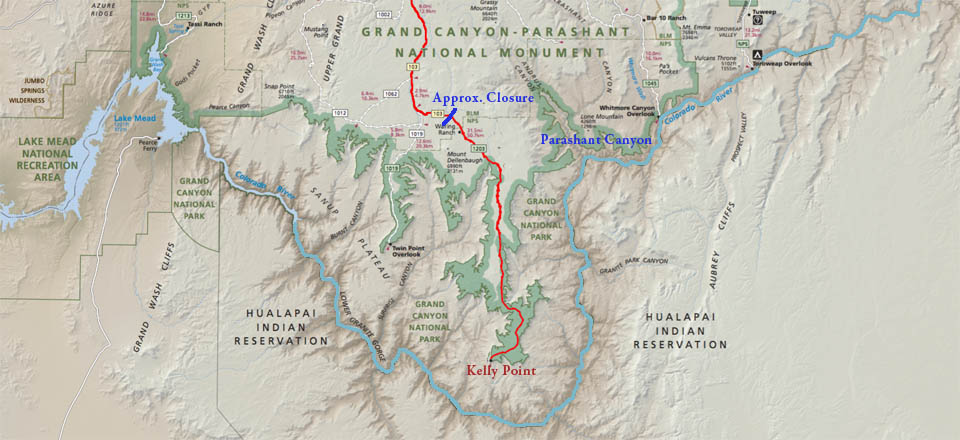On October 15th, 2014, Grand Canyon-Parashant National Monument Superintendent Rosie Pepito announced a seasonal road closure for Kelly Point (NPS Road # 1203) beginning this winter.
Kelly Point Road Closure announcement
The point isthmus itself is managed by Grand Canyon National Park. The place where we believe the road closure is going to occur is at Horse Valley which is managed by GC-Parashant NM. The land managers are slowly squeezing access to the remote places. Besides the nature of this closure, the real issue is one of no public comment. CAC believes the public could have offered a few alternate ideas. To be clear, access to this area in winter is hit and miss. Some winters it’s just not possible with mud and snow. But last winter (2013-2014), it was accessible most of the time. This closure affects access to vast areas of GCNP when weather and water are most suitable for hiking down lower in Grand Canyon.
In response, Rich Rudow has written the following letter to Superintendent Pepito protesting the closure and lack of public comment:
Grand Canyon-Parashant National Monument
345 East Riverside Drive, St. George, Utah 84790
Attention: Superintendent Rosie Pepito
CC: Ray Klein, Scott Sticha
November 11, 2014
RE: Winter closure of the Kelly Point Road
Dear Superintendent Pepito:
The closure of the Kelly Point road completely eliminates access to 50 river miles of Grand Canyon National Park covering hundreds of thousands of acres during winter. The Coalition of American Canyoneers represents the interests of more than 850 canyoneers in the United States many of whom live in the greater Colorado Plateau area. Grand Canyon is a frequent destination via access points through Grand Canyon-Parashant National Monument. Many slot canyons are accessed via the Kelly Point road including Spring Canyon, Indian Canyon, 209 Mile Canyon, Fall Canyon, 214 Mile Canyon, Trail Canyon, Separation Canyon, Green Spring Canyon, and the Amos Spring arm of Surprise Canyon. Some of these canyons are published in Grand Canyoneering and other guide books, while others have been explored but remain unpublished.
Because of water availability and heat, the best time to access these canyons is during the shoulder seasons or winter. Winter access is afforded by driving the roads at night when they are frozen. Access is not possible during heavy winters, or might only be possible with a few weeks of time between storms, but it is possible during mild winters like the one we just experienced. This issue is further exacerbated by the refusal of the Hualapai Nation to issue hiking permits. Many of our members are skilled in the use of packrafts and could access these places by crossing the Colorado River from the South side if Hualapai access was available. As a result, the closure of the Kelly Point road completely eliminates access to nearly 20 percent of Grand Canyon National Park during winter.
We appreciate the need for the Monument to manage road damage and other issues during winter. However, we believe the public could provide the National Park Service with alternate ideas that might afford a better and/or more flexible solution. Furthermore, after hearing from some of our members about the closure, we believe that (under 36 CFR 1.5(b)) a public process should be used for this closure.
I would welcome the opportunity to discuss this with you further at your convenience.
Sincerely,
Rich Rudow
Board of Directors
Coalition of American Canyoneers



